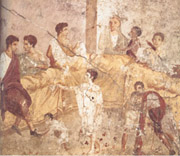
VEGETABLES AND GARUM SAUCE
Finds of charred foodstuffs inform us of what the Pompeians used to eat. As the Pompeians were essentially traders, their diet was often enriched with delicacies imported from other countries, particularly from north Africa and the Orient.
Basically, Pompeian cuisine was rich in fibre, vegetable proteins and minerals. Vegetables and fruit were basic components of the Pompeian diet, along with bread, which was made in several bakeries with their own flour mills alongside. Vegetables were also grown in kitchen gardens and their abundant use in cooking confirms the nickname of “herb eaters” given to the Romans by Plautus. Pliny the Elder classified about one thousand edible pants, many of which were highly praised for their for their therapeutic properties.
A famous type of cabbage grown in the area was well known and highly appreciated in Rome under the name of Pompeii cabbage of “cauliflower”. In De Agricultura Cato praised it as the “supreme vegetable”.
If, during a banquet, you intend to drink a lot and eat with appetite – Cato suggests – have some raw cauliflower before and after your meal and you will feel as if you had not eaten anything at all and you can drink as much as you like.
Several kinds of lettuce very similar to those still in use today ere grown in the countryside around Pompeii as well as endives, flowering broccoli, basil, carrots, cress and leeks. In addition to onions and garlic, which the poorer classes used not only to season all sorts of dishes but also as their main dish, leeks were classed by Pliny as first-class vegetables.
Charred remains of melon seeds, broad beans, peas, chick-peas, and lentils provide precise information on what was produced and thus eaten in Pompeii.
Olives were also a favourite in Pompeii; they were grown throughout the countryside toward the Lattari mountains and, as today, were either pickled in vinegar either salt or used to make oil.
Remains of walnuts, chestnuts and almonds have also been found in some houses, where they were stored on shelves as provisions available for family use.
Several kinds of fresh fruit grown throughout the countryside around the town were on sale in the well-stocked town market, including apples, pomegranates, quinces, pears, grapes, figs and plums. In the years immediately before the eruption fruit trees imported from abroad such as cherry, apricot and peach trees had become more and more common.
The inhabitants of Pompeii adopted sophisticated procedures to preserve vegetables and fruit. Vegetables for the winter were put in vinegar or brine, while fruit was dried and then preserved in honey, which was also used in large quantities mixed with wine.
Well-known cheeses (caseus) and smoked cheeses, were also made from sheep’s or cow’s milk.
The Pompeians used to dress their dishes with a sauce, called garum, which was prepared by soaking several kinds of blue-fish, such as tuna, in brine. Garum was so popular throughout Pompeii that there were several work-shop which produced and sold different blends of this sauce.
This trade was favoured by the existence of the “Salinae Herculeae” and other large salt-works outside the town walls all along the coast. It was there that brine, the indispensable ingredient of the garum sauce, was produced.






